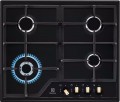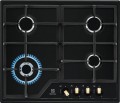—
Retro. Hobs designed in the retro style — while the functionality of such models, usually, is quite modern (similar to
the classic ones). Such models are designed mainly for kitchens of the corresponding design. Retro design is usually expensive, and devices in this category, as well as
hobs of an unusual shape, (see below), with equal performance, are noticeably more expensive than analogues with a classic appearance.
—
Domino. A specific type of compact hobs, usually with one or two burners. The name is because such models in appearance resemble a domino, and two burners enhance the similarity. However, this option is popular not only among hobs but also among grills and fryers (see "Product type"). The domino hob is usually installed across the countertop, from the wall to the front edge. As the main hob, this option is very convenient in cramped conditions when there is not much space in the kitchen. Also, from devices of this type, you can assemble a multi-purpose kit: for example, install a hob, grill and tepan side-by-side. Another application option is the expansion of an existing hob. However, in appearance, dominoes are most often similar to classic models and poorly fit into the retro design.
— Non-standard. Hobs of original designs that do not fit into any of the categories mentioned above. Most of these models
...have a horizontal layout — the width of the surface is much greater than its depth, and the burners are located along the hob. In this case, the number and size of burners can be different; models are produced both with the same heaters and with different sizes. And some designs are made in the form of flat surfaces that do not have protruding parts: touch sensors are responsible for control, and the burners are highlighted only by a pattern on the working part. There are other options, even more extravagant — such as round or teardrop surfaces. Anyway, a custom design can be useful not only from an aesthetic point of view but also from a practical point of view: it can be the best option where it is difficult to install a hob in a more traditional design.General dimensions of the device in width and depth. Depth, in this case, refers to the distance from the leading edge to the trailing edge (when viewed from the user's side). Note that the external dimensions of the hobs are often larger than the dimensions for embedding (see below).

